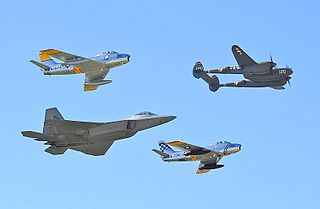This page is based on this
Wikipedia article Text is available under the
CC BY-SA 4.0 license; additional terms may apply.
Images, videos and audio are available under their respective licenses.

The Mikoyan-Gurevich MiG-15 is a jet fighter aircraft developed by Mikoyan-Gurevich for the Soviet Union. The MiG-15 was one of the first successful jet fighters to incorporate swept wings to achieve high transonic speeds. In combat over Korea, it outclassed straight-winged jet day fighters, which were largely relegated to ground-attack roles, and was quickly countered by the similar American swept-wing North American F-86 Sabre. The MiG-15 is often mentioned, along with the F-86 Sabre, as the best fighter aircraft of the Korean War.

The North American F-100 Super Sabre is an American supersonic jet fighter aircraft that served with the United States Air Force (USAF) from 1954 to 1971 and with the Air National Guard (ANG) until 1979. The first of the Century Series of USAF jet fighters, it was the first USAF fighter capable of supersonic speed in level flight. The F-100 was designed by North American Aviation as a higher performance follow-on to the F-86 Sabre air superiority fighter.

The North American F-86 Sabre, sometimes called the Sabrejet, is a transonic jet fighter aircraft. Produced by North American Aviation, the Sabre is best known as the United States' first swept wing fighter that could counter the swept-wing Soviet MiG-15 in high-speed dogfights in the skies of the Korean War (1950–1953), fighting some of the earliest jet-to-jet battles in history. Considered one of the best and most important fighter aircraft in that war, the F-86 is also rated highly in comparison with fighters of other eras. Although it was developed in the late 1940s and was outdated by the end of the 1950s, the Sabre proved versatile and adaptable and continued as a front-line fighter in numerous air forces until the last active operational examples were retired by the Bolivian Air Force in 1994.

The Lockheed F-94 Starfire was a first-generation jet aircraft of the United States Air Force. It was developed from the twin-seat Lockheed T-33 Shooting Star in the late 1940s as an all-weather, day/night interceptor. The aircraft reached operational service in May 1950 with Air Defense Command, replacing the piston-engined North American F-82 Twin Mustang in the all-weather interceptor role.

The North American YF-93 was an American fighter development of the F-86 Sabre that emerged as a radically different variant that received its own designation. Two were built and flown before the project was eventually canceled.

George Welch was a World War II flying ace, a Medal of Honor nominee, and an experimental aircraft pilot after the war. Welch is best known for being one of the few United States Army Air Corps fighter pilots able to get airborne to engage Japanese forces in the attack on Pearl Harbor and for his work as a test pilot. Welch resigned from the United States Army Air Forces as a major in 1944, and became a test pilot for North American Aviation.

The North American F-86D Sabre was a transonic jet all-weather interceptor of the United States Air Force and others. Based on the North American F-86 Sabre day fighter, the F-86D had only 25 percent commonality with other Sabre variants, with a larger fuselage, larger afterburner engine, and a distinctive nose radome.

The General Electric J47 turbojet was developed by General Electric from its earlier J35. It first flew in May 1948. The J47 was the first axial-flow turbojet approved for commercial use in the United States. It was used in many types of aircraft, and more than 30,000 were manufactured before production ceased in 1956. It saw continued service in the US military until 1978. Packard built 3,025 of the engines under license.

The Wright J65 was an axial-flow turbojet engine produced by Curtiss-Wright under license from Armstrong Siddeley. A development of the Sapphire, the J65 powered a number of US designs.

The Canadair Sabre was a jet fighter aircraft built by Canadair under licence from North American Aviation. A variant of the North American F-86 Sabre, it was produced until 1958 and used primarily by the Royal Canadian Air Force (RCAF) until replaced with the Canadair CF-104 in 1962. Several other air forces also operated the aircraft.

"MiG Alley" was the name given by United Nations (UN) pilots to the northwestern portion of North Korea, where the Yalu River empties into the Yellow Sea during the Korean War. It was the site of numerous dogfights between UN fighter pilots and their opponents from North Korea and the People's Republic of China. Soviet-built Mikoyan-Gurevich MiG-15 were the aircraft used during most of the conflict, and the area's nickname was derived from them. It was the site of the first large-scale jet-vs-jet air battles, with the North American F-86 Sabre.
The Sabre Society of North Carolina/Hickory Aviation Museum is a volunteer aviation historical society located at Hickory Regional Airport in Hickory, North Carolina.

The CAC Sabre, sometimes known as the Avon Sabre or CA-27, is an Australian variant of the North American Aviation F-86F Sabre fighter aircraft. The F-86F was redesigned and built by the Commonwealth Aircraft Corporation (CAC). Equipping five RAAF squadrons, the type saw action in the Malayan Emergency in the late 1950s, and was employed for air defence in Malaysia and Thailand in the 1960s. Ex-RAAF models also saw service with the Royal Malaysian Air Force and the Indonesian Air Force.

The North American FJ-4 Fury was a swept-wing carrier-capable fighter-bomber for the United States Navy and Marine Corps. The final development in a lineage that included the Air Force's F-86 Sabre, the FJ-4 shared its general layout and engine with the earlier FJ-3, but featured an entirely new wing design and was a vastly different design in its final embodiment.

Hickory Aviation Museum is an aerospace museum at the Hickory Regional Airport in Hickory, North Carolina. The museum originated from the Sabre Society co-founded by Kyle and Kregg Kirby, when an FJ-Fury, the Naval version of the North American F-86 Sabre was recovered and became the first aircraft of the museum. It features a museum located in the former airport terminal with artifacts, a hangar with aircraft and outdoor exhibits of aircraft on the former airport ramp.
Sabre Jet is a 1953 American Korean War war film drama directed by Louis King starring Robert Stack, Coleen Gray, Richard Arlen, Julie Bishop and Leon Ames. Shot in Cinecolor using United States Air Force footage. Sabre Jet was based on a story by the producer Carl Krueger with the screenplay written by the husband and wife playwright and screenwriting team of Dale Eunson and Katherine Albert. The opening credits state: "This picture is dedicated to the air force wives who shared their men with a world made desperate by the most brutal aggressor in history."


















